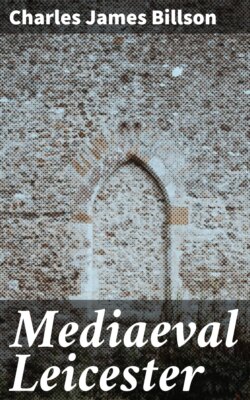Читать книгу Mediaeval Leicester - Charles James Billson - Страница 14
На сайте Литреса книга снята с продажи.
I. THE NORTH SUBURB.
ОглавлениеTable of Contents
BEYOND the North Gate of mediæval Leicester a suburb was in existence from very early times. It contained the Hospital and Church of St. Leonard, and led up to the great Abbey of St. Mary in the Meadows.
The principal thoroughfares were Northgate, Wood Gate, Abbey Gate, The Skeyth or Senvey Gate, and Soar Lane or Walker Lane.
The road lying beyond the North Gate of Leicester, "the highway which leads to the North Bridge," as it is termed in several documents, was generally known as the Northgate. The road so called was outside the walls of the town, for it was parallel with Buxton Lane, and Buxton Lane is stated to have been without the North Gate. In 1462 it was described as "the King's Highway called le Northgate." During the 13th and 14th centuries the district was occupied mainly by dyers and fullers.
After passing over the little North Bridge, the highroad ran through Frog Island, and crossed the main channel of the Soar by another bridge, which was generally known as the North Bridge. Beyond this point the road divided; one branch turning westwards to the Forest, and the other north towards the Abbey. At the point of divergence stood the Church of St. Leonard. The westward road still retains its old name of Woodgate, which it is said to have received because it was the; way by which wood was brought into the town from the forest; and the other road which led to the Abbey was, and still is called Abbey Gate. About the year 1323 it was described as "the street of the Abbey of Leicester."
The Skeyth
, or
Senvey Gate
, ran eastward outside the North Gate under the wall of the town. In 1322 it was called Le Skeyth, and in 1392 Senvey Gate, and in a late 15th century lease it was described as "Le Skeyth alias Senvey Gate." In the early years of the 18th century it was still known as
Senvey Gate, but it would seem that, in the course of that century, the name was altared to Sanvy Gate, and it appears as Sanvy Gate in maps of 1802 and 1828. Nichols rings the changes on Sanby, Sonvey and "Sanvy, quasi
sanda via
," and endorses the questionable etymology of Bickerstaffe or Carte, who satisfied themselves that the word was a corruption of
sancta
or
sacra via
, denoting the sacred way by which, in pre-reformation years, the great religious processions used to go up to St. Margaret's Church. A stone cross, called Senvey Cross, was standing, in the 16th century, at the end of this road, near the North Gate. It has been suggested that this cross was one of those erected to mark the stages of Queen Eleanor's funeral progress, but the evidence seems against this. It is more likely to have been the Cross which Henry, the third Earl of Lancaster, is said to have put up for the soul of his brother, Thomas, "outside the town of Leicester," but this is mere conjecture.
The Soar Lane "extra portam borialem" ran west, outside the North Gate, down to the river. It was also called Walker Lane, or Fullers' Street. In the year 1298 a member of the important family of Curlevache, when he was "amens et demens et ebrius," walked outside the North Gate down Fullers' Street ("invico Fullorum") into the river, and was drowned. In the 14th century it was still known as Walker Gate, or Walker Lane, and was so named in 1417, but, in the course of the 15th century, "Soar Lane" came into use. In 1594 it is referred to as "Soar Lane, or Walker Lane."
Soar Lane does not seem to have run immediately beside the town wall and its ditch; for in 1392 land was conveyed, which is described as being outside the North Gate in " Walkercrofts," and lying between the town ditch and the common footpath. The ditch and its environs were used as gardens; and part of this land belonged to the Priory of the Black Friars, whose grounds were intersected by the town wall.
The land in this district was called "Walkercrofts," or "Crofts." It was divided by ditches, and dykes or raised paths, such as Acedyke, or Ash-lane, and the path called Benacre, both of which seem to have been parallel with Soar Lane, and to have run down towards the river. There was one large plot of land in Walkercrofts, bounded by these ditches and dykes, which lay between the Northgate and the river, known as the Pingle. Its memory is still preserved by Pingle Street. It was described by Nichols as "a large close on the side of Northgate Street, towards the bottom of Soar Lane, edging on the Soar westward not far from the North Gate," and is marked on most of the old plans of Leicester. The word was used in the Midland Counties to denote any small enclosure, and there were other "pingles" at or near Leicester. One at Nottingham was known as Friars' Pingle, "Le Frere Pyngile." On the eastern side of the North Gate in the Parish of St. Margaret, were other lanes and paths, among which were Buxton Lane, parallel with the highway, and perhaps corresponding in part with what was formerly known as Paradise Lane, and a path over a ridge or dyke, known in the 15th century as " Abbot's balk,"
